Incoming freshmen have been excluded from these previews, as we'd like to wait and see what they have to offer on the NCAA level before we come to any long-term conclusions.
-Top NBA Prospects in the ACC, Part One
(#1) James McAdoo
-Top NBA Prospects in the ACC, Part Two
(#2) T.J. Warren
-Top NBA Prospects in the ACC, Part Three
(#3) Rasheed Sulaimon
-Top NBA Prospects in the ACC, Part Four
(#4) P.J. Hairston
-Top NBA Draft Prospects in the ACC, Part Five
(#5) Jerami Grant
(#6) Olivier Hanlan
(#7) Dez Wells
(#8) Rodney Hood
(#9) Joe Harris
-Top NBA Draft Prospects in the ACC, Part Six
(#10) C.J. Fair
(#11) DaJuan Coleman
(#12) Brice Johnson
(#13) Robert Carter
(#14) Jerian Grant
-Top NBA Draft Prospects in the ACC, Part Seven
(#15) Mike Tobey
(#16) Ryan Anderson
(#17) Devin Thomas
(#18) Daniel Miller
(#19) Boris Bojanovsky
#20, K.J. McDaniels, 6'6, Junior, Small Forward, Clemson
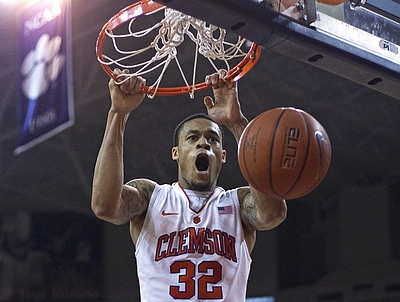
Derek Bodner
Standing 6'6 with a solid wingspan and tremendous athleticism, K.J. McDaniels became a much bigger part of the Clemson Tigers team during his sophomore season, as he saw his minutes increase from 10.1 minutes per game during his freshman season to over 27 per night last year and upped his scoring from a meager 3.9 points per game to 10.9.
Athleticism is the basis of McDaniels' intrigue as a prospect, as he possesses excellent open court speed and explosive leaping ability, making him a highlight waiting to happen. This gives McDaniels all kinds of advantages in the transition game, where he uses his speed to get out ahead of the break and finishes with spectacular displays of athleticism. It also presents itself off on the offensive glass, where you routinely see McDaniels soar in and throw a putback down with authority.
To build on top of this, McDaniels has worked hard to add a spot-up game to his repertoire, giving him a much more prominent role in the half-court. While McDaniels can be streaky at times, he has re-worked his release and now has a very quick and compact release, making him a threat in catch and shoot situations. According to Synergy Sports Technology, McDaniels made 39% of his attempts with his feet set, albeit on a fairly limited sample size. With more repetition, this looks like it could become a more prominent and consistent part of his arsenal, which would greatly enhance his draft stock.
Creating off the dribble is where McDaniels' deficiencies begin to show up. He is able to find some offense from simple straight line drives to the basket, particularly when his defender closes out a little bit too aggressively on him, but his ball-handling skills are relatively primitive for a wing player and he struggles to get all the way to the rim regardless of which direction he's driving. This is compounded by the fact that he doesn't have a reliable pull-up gamehe made just 22% of his off the dribble jumpers last season--and struggles in general with his balance and footwork when shooting off the dribble, and hasn't yet developed much in terms of pull-ups or floaters in the lane.
While his half-court game is largely as a standstill, catch and shoot player, McDaniels' ability to draw fouls in transition, off of cuts and from offensive rebounds keeps his free throw rate respectable at 4.3 free throw attempts per 40 minutes pace adjusted, despite his struggles creating offense off the bounce.
Perhaps not surprising due to his lack of shot creation ability, McDaniels doesn't present much of an asset as a passer, generating only 1.2 assists per 40 minutes pace adjusted. He does do a good job of rotating the ball on the perimeter, with the ball not frequently getting stuck in his possession for very long.
On the defensive side of the ball, McDaniels' physical attributes once again shine. His 3.2 blocks per 40 minutes pace adjusted far outshines any other swingman in our database. In fact, you would have to go back to Dominic McGuire at Fresno State in 2006/2007 to find a wing prospect with a higher total. He also possesses good lateral quickness, a solid wingspan, and a strong upper body, making him a good defensive prospect. He does a good job of fighting through screens and giving effort on this side of the court, although he can at times get too upright on the perimeter and be prone to misdirection.
A relative unknown in high school who played a marginal role as a freshman, K.J. McDaniels' improvement last season combined with his physical profile presents a fair amount of intrigue as a prospect, and his development of a reliable catch and shoot game is the first (and very important) step in diversifying his skill set on the perimeter. With Clemson losing Devin Booker and Milton Jennings to graduation, McDaniels will have to shoulder a much heavier load in the half-court and will be relied upon to create more offense for both himself and his teammates. Continuing to improve his ball-handling, while showing further improvement in his shooting, will be important for McDaniels going forward. If he continues to show progress with his skill-set, he has a chance to draw some serious attention to himself as pro prospect moving forward.
#21, Justin Anderson, 6'6, Guard/Forward, Sophomore, Virginia
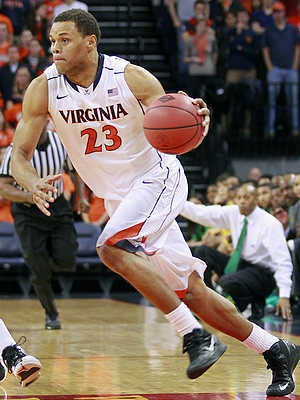
Kyle Nelson
The first time we wrote about Justin Anderson in 2009, the then 15-year old was garnering consideration as possibly the best high school freshman in the country. Though he was unable to sustain these lofty expectations, he solidified himself as a consensus top-50 recruit and committed to an upstart Virginia program that was coming off of a trip to the NCAA Tournament. After a slow start to his college career, Anderson started Virginia's last 17 games en route to an appearance in the NIT Quarterfinals, finishing the season off on a very positive note. With that in mind, expectations are higher for his sophomore season, and scouts will be watching to better get a sense of what he can offer at the next level.
Though he passes the eye test and then some at the collegiate level, Anderson's height--he stands 6'6 with a chiseled 225-pound frame -- situates him as average among small forward prospects in our database. Though he is not the tallest wing prospect in our database, he is incredibly strong to go along with a 6'11 wingspan and standout athleticism. Furthermore, reports from summer workouts indicate that he has improved his mobility, particularly by improving his balance, agility, and core strength, which could result in increased quickness in the half court to go along with his explosiveness around the basket.
While Anderson's physical and athletic profiles are impressive, scouts were eager to see how he would adjust to NCAA-caliber competition. The results were decidedly mixed, as he was not particularly productive early on, but proved himself to be one of the more versatile freshmen wings in the ACC.
Anderson's offensive game relies heavily on his jump shot, straight-live drives, and transition forays. He was not a particularly prolific-shot creator as a freshman, getting to the free throw line at an average rate.
As a slasher, Anderson put his frame and athleticism to good use, barreling through defenders on his way to the basket and finishing well above the rim when given the opportunity. While he is outstanding running and finishing in transition, he lacks much in the way of advanced ball-handling moves, and he converts just 47.3% of his overall shots inside of the arc. Additionally, he is not the most effective finisher around the basket at this stage, despite his strong frame, making a somewhat average 50% of his looks at the rim. Ball-handling is not his forte and it is rare to see him engage his defender with advanced moves or via fakes. His mid-range game also leaves something to be desired, as he doesn't possess a very effective pull-up jumper at this stage either.
While Anderson certainly does not shy away from contact, he tends to force contested shots around the basket and does not have the softest touch inside the paint at this point in his career, particularly with his right hand, which he tends to avoid as a natural lefty. Looking forward, his strength and athleticism should allow him to make considerable gains in this area as it will for his mid-range game, as well -- if he continues to develop his off hand and hones his scoring instincts inside of the arc.
Another aspect of his slashing game worth mentioning is his well above-average passing ability. Anderson's court vision as a swingman is intriguing, in part because he did an excellent job of finding teammates in transition by drawing defenders in the lane and dishing off to open players around the basket. He ranked as the fifth most prolific passer among all small forward prospects in our database with the third best assist/turnover ratio. His ability to move the ball around the perimeter, dish off the bounce, and make post-entry passes distinguishes him from other wing prospects and adds another valuable element to his game that he can hang his hat on.
Though his potential as a slasher is intriguing, Anderson saw 58.2% of his offensive possessions during his freshman year as a jump shooter, making just 32.1% of his overall jump shots. His shooting mechanics are not that bad, though, as his comfort level with his jumper seemed to increase as the year moved on. Not being a great ball-handler, it will be important for Anderson to make strides with this part of his game as his career moves on, as his ability to space the floor will play a major role in the type of niche he'll be able to carve out in the NBA.
Where he truly excels at this stage, however, is on the defensive end. His length, lateral quickness and strength allow him to guard multiple positions at the collegiate level, and it's not a stretch to envision that translating to the NBA level as well. Watching him run through screens, body up big men inside and outside, grab defensive rebounds in traffic, interrupt passing lanes, and block shots while trailing his man point to the versatility that he showed as a freshman and the potential that he has moving forward. The fact that he was one of only four perimeter players in our database to average at least 1.5 steals and 2.0 blocks per 40 minutes pace adjusted last season stands out as well. While he wasn't immune to making mistakes as a freshman due to his lack of experience, there is little doubt that he will continue to improve in this capacity moving forward.
Anderson will be a key contributor on a Virginia team that is poised to make a run in the NCAA Tournament and should capitalize on the visibility that comes along with these increased expectations. He also will benefit from the opportunity to prove himself on a nightly basis against some of the best wing prospects in the country in a tough ACC schedule. Though he may be a year or more away from garnering significant NBA attention, expect him to rise in these rankings at this time next year if he can increase his productivity and efficiency without sacrificing his versatility.
#22, Akil Mitchell, 6-8, Senior, PF, Virginia
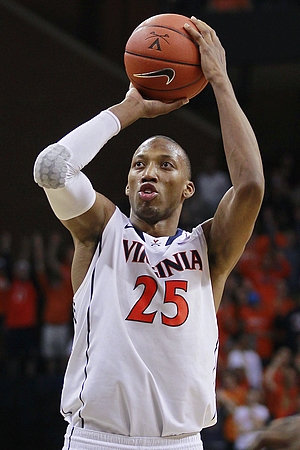
Josh Riddell
No longer buried behind the graduated Mike Scott, Akil Mitchell saw a nice uptick in his minutes played from 22 to 30.5 per game, which lead to an increase in his point production from 4.1 to 13.1 points per game in his junior season.
Mitchell does not have great height at 6'8 ½ in shoes, but he compensates for that with a solid 6'11 ½ wingspan and a very strong 232 pound frame. His athleticism is what stands out and his greatest asset at this point, as the energy he provides to the team is fueled by it. He runs the floor well in transition and complements this skill well by being an excellent finisher at the rim, as he shot 65.7% around the basket last season, according to Synergy Sports Technology.
Mitchell is a great rebounder, especially on the defensive end, where he averaged 8.7 rebounds per 40 minutes pace adjusted which ranked 3rd among all returning top-100 prospects. His offensive rebounding numbers of 3.8 per 40 minutes pace adjusted aren't as good but this may have more to do with the system he plays in, which places a major premium on transition defense. He shows the same hustle and ability to chase down rebounds on the offensive end, but he doesn't get many opportunities to crash the glass in Tony Bennett's system.
Much of Mitchell's halfcourt offense comes from his own court awareness, as he cuts to open spaces so that teammates can deliver him the ball in scoring opportunities. He rarely creates offense for himself off the dribble and relies on teammates getting him the ball close to the rim for points. He has the basis to be a decent post player, as he showed a nice drop step complemented by a hook shot that he can convert with either hand, but he may have trouble if stronger players try to push him away from the block.
Mitchell is not a jump shooter, as he took only 37 jumpers last season, according to Synergy Sports, where he shot 32%. However, he shows good form on his release and could become a reliable mid-range jump shooter with a little bit of work.
Defensively, Mitchell struggles against ACC players and will find himself in a similar bind against tougher competition. He can get backed down by bigger and stronger players in the post, while he struggles to guard quicker players on the perimeter. Against the pick and roll, he often hedges out too hard and is slow to recover, leaving the defense vulnerable as he is caught in no man's land when the guard is able to dribble around him.
He uses his energy well on the defensive end as he flies around the courts at times to challenge shots and create turnovers. His 1.8 steals per 40 pace adjusted tied for third among top-100 power forwards last season. He'll need to bring this kind of energy every night to make up for his deficiencies in other defensive areas.
Seeing most of his minutes at the center position last season in front of talented freshman Mike Tobey, Mitchell will likely spend more time at power forward this year alongside the developing 6-11 interior player, which should be beneficial for him considering he's too undersized to play that position in the NBA. Showing he can hold his own against some of the better power forwards he'll face defensively will be an especially important test for him.
Mitchell will be a key contributor to an experienced Virginia team who is looking to improve off their 23-12 record and NIT quarterfinal berth last season. It will be tough for Mitchell to show his skills that will translate to the NBA in a system that doesn't always showcase his strengths as a player, so he'll need to keep his motor level high to catch the eye of NBA scouts. He will then need to improve on the defensive end, showing he can guard a specific type of professional caliber player, to be taken seriously as a prospect.
#23, Talib Zanna, 6'9, Senior, Power Forward/Center, Pittsburgh
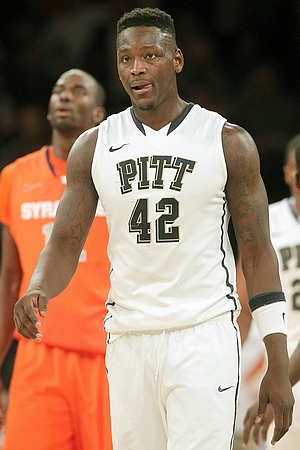
Matt Williams
Now in his fifth year at Pitt, after redshirting his freshman year due to a shoulder injury, Talib Zanna will look to build on a solid season that saw him average 9.6 points and 6.1 rebounds per-game slotted as Pittsburgh's starting power forward next to Steven Adams. With Adams moving to the NBA ranks early and Dante Taylor graduating, Zanna will play a key role in Jamie Dixon's team's success this season as the program's only returning big man with significant D1 experience.
Getting off to a fast start last season, Zanna cooled off significantly as the year went on. He averaged a tremendous 25.2 points and 12.1 rebounds per-40 minutes pace adjusted through December 31st, but posted averages of 11.7 points and 10.7 points per-40 minutes pace adjusted over the last three months of the season as the competition stiffened. Poised to see more touches offensively this season, Zanna will have ample opportunity to bounce back and assume a larger role as the veteran presence in an inexperienced front court.
Standing 6'9 with good length and a strong frame, Zanna looks the part of an NBA power forward. An active, mobile big man, he was the third leading scorer for the Panthers last season, despite his role revolving almost exclusively around his ability to finish the opportunities his teammates created for him. A fairly unrefined scoring threat, the Nigeria native remains inconsistent as a scorer away from the rim, is limited with his back to the basket, and struggled to finish in the paint at a high level to close the year. He flashes soft touch and will toss in a hook shot from time to time, but does most of his damage catching and exploding to the rim, still having plenty of room to grow and develop his skill level on the offensive end.
Where Zanna has proven capable of making a significant impact over the course of his collegiate career has been on the offensive glass, like many former Pitt big men. Doing a tremendous job using his athleticism, length, and aggressiveness to corral 4.9 offensive boards per-40 minutes pace adjusted, his willingness to mix it up in the paint offensively and create extra possessions for his team is one of his most significant attributes as an NBA prospect.
Despite his impressive production on the offensive glass, Zanna averaged a much less robust 5.9 defensive rebounds per-40 minutes pace adjusted last season, seldom pursuing the ball out of his area, but doing a fine job boxing out. A foul prone player early in his career, Zanna has improved his fundamentals on the defensive end by leaps and bounds in his time under Jamie Dixon. He may not block many shots, but he has become adept at going straight up on would-be scorers in the post and shows terrific foot speed for a big man defending the perimeter.
Pittsburgh will feature a lot of new faces in 2014, and Zanna will be counted on to step up and assume a leadership role. His size, athleticism, and offensive rebounding ability give him some intrigue as a prospect, but showing more variety offensively and improving on the defensive glass could help his standing in the eyes of scouts considerably. A strong candidate for the Portsmouth Invitational Tournament, Zanna is a player worth keeping tabs during Pitt's first run through the ACC, despite turning 23 years old in a few weeks.
#24, Montay Brandon, 6-7, SG/SF, Sophomore, Florida State
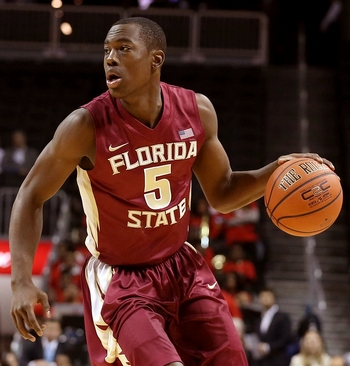
Joe Treutlein
Montay Brandon had an underwhelming freshman campaign from a production standpoint, averaging just 3.9 points and 1.8 rebounds in 19.8 minutes per game while not being particularly efficient, but the 6'7 wing is an intriguing player due to his physical tools and the flashes of skills he displayed, which is one of the reasons he could take a big step forward as a sophomore.
Standing 6'7 with good length, a solid frame, and excellent athleticism, Brandon is a very active player on both ends of the floor who has a groundwork of skills in a variety of areas.
On the offensive end, Brandon's slashing game is the most developed skill in his arsenal, as here he takes advantage of a good first step, passable ball-handling ability on right-handed drives, and superb leaping ability along with the strength, toughness, and willingness to finish with power through contact. Like all areas of his offensive game, Brandon is noticeably lacking in polish here, not having the greatest of footwork or awareness at times, and being very turnover prone relative to his modest usage, but he shows good instincts and enough grasp of spin moves and hop-steps to make this an effective area of his game already.
Brandon's finishing ability in the paint area is already very good relative to his modest production, as he's highly capable of finishing with both runners and floaters or going up with power for highlight-reel dunks. He shows good touch around the rim and has all the physical ability to finish effectively at any level, though his efficiency (47.1% two-point percentage) still isn't great as he doesn't yet have the shot-creation abilities to consistently put himself in position for high-percentage shots.
Brandon's jump shot isn't quite as far along as his slashing game yet, but he shows promise in this area, boasting good form with clear-cut NCAA three-point range, passing the eye test on many of his attempts. The numbers don't yet back this up, as he shot just 29% from behind the arc (on less than one attempt per game) and an even less impressive 48.9% from the free-throw line (on 1.4 attempts per game). Improving in this area is clearly the area of his game that can return the highest dividends, and would greatly boost his long-term stock given his profile and the types of players in his mold that have previously succeeded in the NBA.
One encouraging aspect of Brandon's offensive game at this stage is despite his overall lack of polish, he actually does a pretty good job at a lot of little things, often being called upon to bring the ball up the floor, initiate the half-court offense from the top of the key, and also shows solid ability making flow-of-the-offense passes, to the tune of 2.8 assists per 40 minutes pace adjusted. While these likely aren't things he'd ever be asked to do consistently at the next level, the versatility is a positive and if expanded on gives him the potential to play both the 2 and 3 positions, especially if he improves his perimeter shooting.
On the defensive end of the floor, Brandon is a much more effective overall player, having a good fundamental base to go along with his excellent physical tools. He's aggressive in man coverage both on and off the ball, moves his feet well, and does an excellent job sticking with his man and contesting shots on drives to the basket. He could stand to contribute more in the rebounding department, as 3.6 boards per 40 minutes pace adjusted is pretty lackluster for someone with his size and athleticism, but that's hardly a make-or-break issue for him.
Looking forward, Brandon will need to build on the intriguing flashes he showed as a freshman by translating it to consistent production on the offensive end in order to place himself firmly on NBA team's future draft radars. Improving his perimeter shooting ability will also likely be critical for him, though he still has room for strides in all areas given his still relatively raw game overall. With fellow wing Michael Snaer (last year's leading scorer on the team) graduated and now out of the picture, Brandon should have plenty of opportunities to expand his role this year, and he's definitely someone to keep an eye on in the years to come.
































Comments